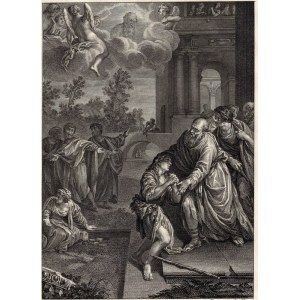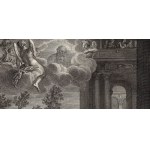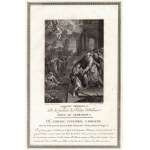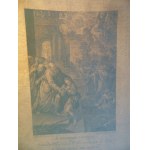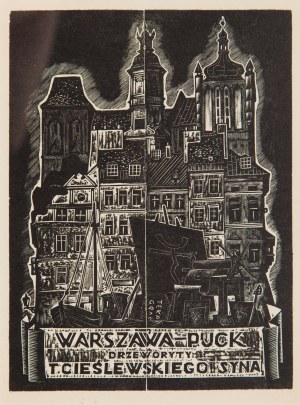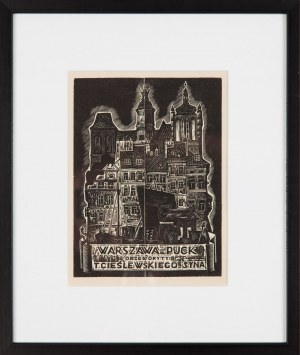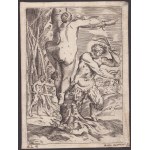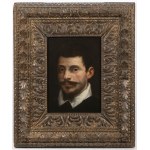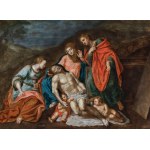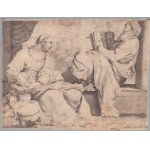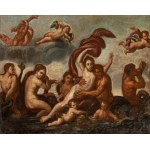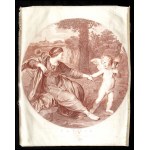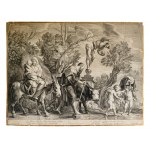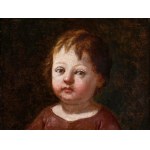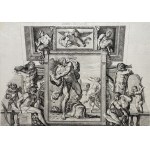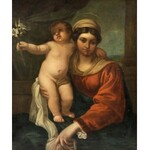The prodigal son returns to his father.
42.2 x 29 cm
After a lost painting by Annibale Carracci (1560-1609).
The painting is lost and is known through a series of drawings, most of which are attributed to Agostino. The attribution to Annibale is traditional (source British Museum)
Engraving executed by Jean Baptiste Tailliard in Paris circa 1786.
In excellent condition. Very good, strong, dark, detailed impression.
Printed on handmade paper with 8-15mm margins.
Some signs of age, not disturbing.
Image size: 21.0 cm x 15.0 cm
Engraving size: 42.2 cm x 29.0 cm
With good watermark.
Annibale Carracci (born November 2[1 ] 1560 in Bologna, died. July 15 ,1609 in Rome) - Italianpainter, draughtsman, printmaker and frescoist of the early Baroque period , the main representative of the of theBologneseschool, co-founder of theCarracci Academy, creator of modern caricature, brother of AgostinoCarracci, cousin ofLudovic Carracci.
He came from a family of craftsmen. He was the son of Antonio the tailor. He probably studied under the Bolognese Mannerists Bartolomeo Passarotti and Prospero Fontana. He was active in Bologna and Rome. He traveled to Parma (1584-1585) and Venice (1587).
In 1583 he presented his first composition to the public - an altarpiece painting of the Crucifixion intended for the small church of San Niccolo in Bologna. He was co-author of the wall paintings in the palaces of Bologna: Fava(History of Europe and History of Jason - 1583-1584, History of Aeneas - c. 1586), Magnani Salem(History of the Founding of Rome - c. 1589-1590) and Sampieri Talon(Biblical Scenes - 1593-1594).
Together with his brother Agostino and cousin Ludovico, he founded the Bologna Academy in 1585. In 1595 he went to Rome permanently at the urging of Cardinal Odoardo Farnese, where he executed frescoes in his palace. In 1602 he developed the cartouches for a series of paintings for Rome's Herrera de San Giacomo degli Spagnioli chapel.
He did not attach importance to fame and money (he warned his brother, "Remember, Agostino, that you are the son of a tailor"). He did not start a family and had no children. He died at the age of 49. He was buried in the Pantheon next to Raphael.
His pupils and collaborators included Francesco Albani, Domenichino, Giovanni Lanfranco, Sisto Badalocchio and Agostino Carracci' s illegitimate son Antonio.
Caravaggio called him "a capable man" and "a good painter." According to Bernini, "he brought together everything good: the graceful line of Raphael, the thorough anatomy of Michelangelo, the elegant manner of Correggio's painting, the color of Titian and the fantasy of Giulio Romano and Mategni."[2]
Creativity
Referring to the patterns of the mature Renaissance, he represented the classical current in Baroque painting. He painted large altarpieces, easel paintings of religious, mythological and allegorical themes, genre compositions, portraits (including numerous self-portraits), nudes and landscapes. He worked under the influence of Leonardo da Vinci, Raphael, Titian, Correggio and Veronese. He initiated the type of ideal landscape(Escape to Egypt), exerting great influence on the development of this genre in the 17th century(Domenichino, Nicolas Poussin, Claude Lorrain). In his religious compositions he skillfully combined Venetian colorism, Tuscan drawing and Lombard naturalism. He reconciled two different approaches to the essence of painting, giving priority to neither color (Venetian model) nor drawing (Roman and Florentine model).
He was an excellent draughtsman. His series of genre drawings Arti di Bologna was published in 1630. The largest collections of his studies and sketches are today in the Louvre and Windsor.
Frescoes in the Palazzo Farnese
His most outstanding work is the frescoes in Rome's Palazzo Farnese, depicting mythological scenes linked by the common theme of love (1596-1601), commissioned by Cardinal Odoardo Farnese. The program of mythological and allegorical scenes for the Camerino (a small private study) and Ovid's Gallery was designed by the humanist Fulvio Orsini, who served as the cardinal's court librarian. The Gallery's vaulted ceiling featured episodes taken mainly from Ovid's Metamorphoses. The individual scenes, placed in a narrow 20 x 6-meter room with a semicircular barrel vault, were inscribed in an illusionistically treated architectural structure, complemented by antique ornaments and medallions(quadri riportati). The main painting on the plafond depicts the two deities, Bacchus and Ariadne, on chariots drawn by leopards and goats. In front of them on a donkey rides a drunken Silene supported by naked young men dancing and playing various instruments. The triumphant procession wanders against the backdrop of a luminous landscape. He was assisted in the realization of the monumental painting on an ad hoc basis by his brother Agostino and the young Bolognese painters Domenichino, Giovanni Lanfranco and Francesco Albani, who were still little known at the time. The decor of the Palazzo Farnese Gallery, along with Michelangelo's frescoes in the Sistine Chapel and Raphael's stanzas, is among the most outstanding sets of wall paintings in Rome and had a decisive influence on the development of decorative illusionist painting of the second half of the 17th century in Italy and France.
Selected works
- Mourning Christ - 1580, 191 x 156 cm, Hermitage, St. Petersburg
- Head of a laughing young man - 1583, Borghese Gallery, Rome
- Crucifixion with the Saints- 1583, 305 x 210 cm, Santa Maria della Carità, Bologna
- St. Sebastian- 1583-84, 186 x 107 cm, Old Masters Picture Gallery, Dresden
- Baptism of Christ - 1584, San Gregorio, Bologna
- Body of Christ - 1583-85, 77 x 89 cm, Staatsgalerie, Stuttgart
- Pieta (Picture from the Cross with the Virgin Mary and Saints Clare, Francis, Magdalene and John) - 1585, Galleria Nazionale, Parma
- Mystical Nuptials of St. Catherine - 1585-87, Museo di Capodimonte, Naples
- Fishing - ca. 1587, 136 x 253 cm, Louvre, Paris
- Assumption of Mary - 1587 , 381 x 245 cm, Old Masters Picture Gallery, Dresden.
- TheHunt - 1585-88, 136 x 253 cm, Louvre, Paris
- Throning Madonna with St. Matthew - 1588, 384 x 255 cm, Old Masters Picture Gallery, Dresden
- Venus with satyr and cupids - ca. 1588, 112 x142 cm, Uffizi, Florence
- St. Francis of Assisi - 1585-90, Museo di Capodimonte, Naples
- Children teasing a cat - 1588-90, 66 x 89 cm, Metropolitan Museum of Art, New York.
- Eating beans - 1580-90, 57 x 68 cm, Galleria Colonna, Rome
- Butcher's Shop or Butcher's Slaughter - 1580-90 , 185 x 266 cm, Christ Church Picture Gallery, Oxford
- Madonna with Child and Swallow - 1589-90, 101 x 85 cm, Old Masters Picture Gallery, Dresden
- Venus and Adonis - 1590, 217 x 246 cm, Kunsthistorisches Museum, Vienna
- Assumption of Mary - ca. 1590, 130 x 97 cm, Prado, Madrid
- River Landscape - ca. 1590 , 88.3 x 148.1 cm, National Gallery of Art, Washington, DC
- Man with Monkey - 1590-91, 68 x 58 cm, Uffizi, Florence
- Madonna with Child and Saints (St. Luke's Altarpiece) - 1592, 401 x 226 cm, Louvre, Paris
- Bow of the Shepherds - 1593, 85 x 63 cm, Galleria Nazionale d'Arte Antica, Rome
- Self-portrait with the artist's father, brother Agostino and his son Antonio - 1593, 60 x 48 cm, Pinacoteca Brera, Milan
- Portrait of lute player Giulio Mascheroni - 1593-94, 77 x 64 cm, Old Masters Picture Gallery, Dresden
- Christ and the Samaritan Woman - 1593-94, 170 x 225 cm, Pinacoteca Brera, Milan
- Christ on the Cross - 1594, 33.8 x 23.4 cm, Gemaldegalerie, Berlin
- Alms of St. Roch - 1594-95, 331 x 477 cm, Old Masters Picture Gallery, Dresden
- Self-portrait on an easel - 1595, 36.5 x 29.8 cm, Uffizi, Florence
- Coronation of the Virgin Mary - 1595, Metropolitan Museum of Art, New York.
- Venus combed by three Graces - 1590-95, 133 x 170.5 cm, National Gallery of Art, Washington, DC
- Venus, Adonis and Cupido - ca. 1595, 212 x 268 cm, Prado, Madrid
- The Choice of Hercules - ca. 1596, 167 x 273 cm, Museo di Capodimonte, Naples
- Christ mocked - ca. 1596, 60 x 69.5 cm, Pinacoteca Nazionale, Bologna
- Christ in Glory - 1597-98, 194 x 142 cm, Galleria Palatina, Florence
- Temptation of St. Anthony - 1597-98, 50 x 34 cm, National Gallery, London
- Landscape with Penitent Magdalene - ca. 1598, 32 x 43 cm, Old Masters Picture Gallery, Dresden
- Head of a man - 1595-99, 46 x 37 cm, Galleria Palatina, Florence
- Self-portrait in profile - 1590-1600, Uffizi, Florence
- Sacrifice of Abraham - 1599-1600, 45 x 34 cm, Louvre, Paris
- Pieta - 1599-1600, 156 x 149 cm, Museo di Capodimonte, Naples
- Three Marie at the Tomb - ca. 1600, 121 x 145 cm, Hermitage, St. Petersburg
- Assumption of Mary - 1600-1601, 245 x 155 cm, Santa Maria del Popolo, Rome
- Christ appearing to St. Peter on the Via Appia (Quo vadis, Domine?) - 1601-02, 77 x 56 cm, National Gallery, London
- Rinaldo and Armida - 1601, Museo di Capodimonte, Naples
- Sleeping Venus - ca. 1602, 190 x 328 cm, Musée Condé, Chantilly
- Stoning of St. Stephen - 1603-04, 41 x 53 cm, Louvre, Paris
- Martyrdom of St. Stephen - 1603-04, 51 x 68 cm, Louvre, Paris
- Flight to Egypt - 1603, 122 x 230 cm, Galleria Doria Pamphilj, Rome
- Rest during the flight to Egypt - ca. 1604, 82.5 cm dia, Hermitage, St. Petersburg
- Self-portrait - ca. 1604, 42.5 x 30 cm, Hermitage, St. Petersburg
- Self-portrait - turn of 16th/17th century, until the war in the collection of the Ordynacja Zamojska in Warsaw, lost
- Christ and the Samaritan Woman at the Well - 1604-05, 60.5 x 146 cm, Kunsthistorisches Museum, Vienna
- Mourning Christ - 1606, 92.8 x 103.2 cm, National Gallery, London
- Pieta with Saints Francis and Magdalene - 1602-1607, 277 x 186 cm, Louvre, Paris
- Birth of Mary - 1605-1609, 279 x 159 cm, Louvre, Paris
- Landscape with Toilet of Venus - 1605-1610, 89 x 99 cm, Pinacoteca Nazionale, Bologna
- Madonna with Child and Little St. John - ¶ 29 cm, Prado, Madrid
- Landscape with bathers - 47 x 56 cm, Prado, Madrid
- Portrait of a bearded man in profile - 34 x 27 cm, Kunsthistorisches Museum, Vienna
- Portrait of a young man - 90.5 x 39 cm, Galleria Nazionale d'Arte Antica, Rome
- St. Margaret - 239 x 134 cm, National Gallery of Australia, Canberra



